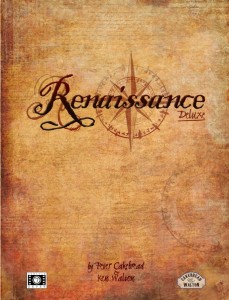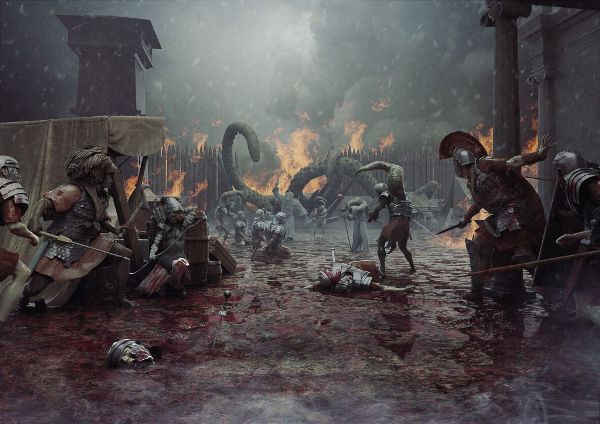Renaissance Deluxe
Renaissance Deluxe is a black powder fantasy rules system written by Ken Walton and Peter Cakebread and published by Cakebread & Walton.
By Aaron T. Huss

Learn more about Renaissance Deluxe here
Purchase Renaissance Deluxe here
Find other Renaissance products here
Renaissance Deluxe is the extended version of the Renaissance SRD and is the latest addition to the d100 family that includes RuneQuest, Legend, OpenQuest, and Basic Roleplaying. In regards to those systems, it was built off the OpenQuest system and resembles a mash-up of OpenQuest and RuneQuest or Legend. To me, it seems like a simpler version of Legend or a more intuitive version of OpenQuest (essentially it lies somewhere in the middle). Renaissance is designed for black powder (fantasy) settings and nominally set in the early modern period of Earth’s history (which includes the Renaissance era).
Renaissance is a roll-under d100 system where the majority of dice rolls are made against a list of common and advanced skills formed by either adding two base characteristics or by doubling a single characteristic. Each character then receives a number of skill points to improve those skills and thus create their own character archetype. Each character is defined by a social class, profession, and faction. Social classes are a character’s background that defines what professions are available. Professions define what a character did BEFORE they became an adventurer. Factions define what the character’s believe in the most. All of this defines a character’s background and beliefs but does not hamper their ability to advance and become whatever they want. Obviously they don’t get the inherent bonuses for social class and profession, but characters are never limited by a given character class or archetype. This is the same method as the aforementioned d100 systems.
According to Cakebread & Walton, Renaissance Deluxe has expanded content in Factions, Equipment, Alchemy, Witchcraft, and Bestiary. The Sanity and GM chapters are new plus quick rules are included for combat and naval combat.
CONTENT
Introduction is the essential introduction to role-playing containing much of the same information seen elsewhere. In addition, it introduces the different eras for black powder fantasy covering the early modern period and a note on historical/alternate history gaming.
Character Creation is all about building a character in regards to their characteristics, attributes, common skills, social class, advanced skills, connections and notes about professions and factions. Much of this will be very familiar to players of RuneQuest, Legend, and OpenQuest.
Profession is a list of professions, their requirements, and the bonuses they provide.
Factions is a list of factions and the mechanics surrounding Righteousness. Factions are an integral part of the original Clockwork & Chivalry setting surrounding the high amount of turmoil between the clashing factions of the renaissance period. This is carried over to Renaissance Deluxe as a core mechanic, but is not integral to the system. In other words, if you don’t want to use factions, you can remove them without breaking the system. However, they present the players and GM with a lot of great plot hooks generated using inter-faction dispute and the use of Righteousness.
Skills is the detailed mechanics surrounding the use of skills and an in-depth description of the different common and advanced skills.
Combat is the full description of the mechanics surrounding all aspects of combat: close, ranged, mounted, unarmed, movement, and reactions. This section also goes into greater depth into wounds and hit points.
Rules and Systems describes situational rules for the system such as travel, weather, lighting, fatigue, encumbrance, falling, suffocation, and resistance. This section also includes a list of poisons and illnesses along with discussing character advancement. Near the end of this section is an introduction to using boats, ships, and airships, although not a very in-depth look.
Equipment is a listing of the different equipment available in black powder fantasy settings and the early modern era including clothing, everyday items, food, inns and taverns, specialist equipment, transportation, weapons, artillery, and armor.
Alchemy goes into detail about the mechanics surrounding alchemy including the philosopher’s stone, how to use spells, and a long list of alchemist spells. This section also includes information about summoning elementals, the creation and use of potions, and the creation and use of familiars.
Witchcraft goes into detail about the mechanics surrounding witchcraft, designed more for NPCs than it is for PCs. This includes everything needed for understanding how witchcraft works, casting and acquiring spells, spell ingredients, and a lengthy list of spells.
Bestiary is a listing of creature adversaries from natural to supernatural.
Sanity is an optional system in Renaissance and is fully detailed here. I felt it should be placed near the Rules and System section, but at least it is fully described. Sanity includes all the mechanics surrounding sanity checks, insanity, the use of hero points, mental armor, mental healing, and the horror rating associated with certain bestiary.
Games Mastering is a list of tips and tactics for the GM including a look at constructing different game settings, creating adventures, notes on running games, and a listing of general NPCs with basic stats for general use.
OVERALL
I hate to say this because it sounds biased, but this is by far my favorite implementation of the d100 systems that include OpenQuest and Legend. For as much as I like both of those systems, Renaissance removes the things I don’t like about those systems. It removes some of the combat complications of Legend while adding more options compared to OpenQuest. The only drawback I see is that it’s tied too heavily to Clockwork & Chivalry in terms of only offering Alchemy and Witchcraft along with equipment that is tied heavily to to early modern Earth. While this is a slight drawback, it does mean that other settings will require new mechanics/options in those areas (although remember that Renaissance is designed to recreate the early modern era with a fantasy twist). However, due to its inherent compatibility with OpenQuest, RuneQuest, and Legend, you can easily pull from any number of already available sourcebooks and core setting guides for that information.
RATINGS
Publication Quality: 9 out of 10
I applaud Cakebread & Walton with their continued improvements to their publication quality from their beginnings with the 1st edition of Clockwork & Chivalry up to Renaissance Deluxe and beyond. There are some very little things in regards to cleaning up the formatting, but they’re completely minor and by no means interfere with the content. However, this is just a sidebar to what is truly awesome about Renaissance Deluxe. Early Modern and Black Powder Fantasy artwork is something you do not come across very often. Following with the style of artwork found in Clockwork & Chivalry, Renaissance Deluxe has an excellent collection of rustic feeling artwork depicting Early Modern times and the technology within the core mechanics. While you may not think that means much, Black Powder Fantasy and the Early Modern period is somewhat rare in role-playing games and you don’t see a lot of period-appropriate artwork.
Mechanics: 10 out of 10
This may sound a little biased, but the Renaissance system removes all the mechanics I find to be bulky in Legend (RuneQuest II) while avoiding the overly simple implementations from OpenQuest. It is an excellent implementation of the d100 mechanics that harken back almost 35 years. Yes it is tied directly to the era it’s meant to represent, but it can easily be modified for similar eras or other interesting settings due to the strength of the core mechanics.
Desire to Play: 8 out of 10
If you are looking for black powder or historical fantasy set in the early modern period, then Renaissance is the perfect fit. However, it does have a slight drawback in that those themes are integral to the system and are difficult to avoid. If you want to change the flavor to match a slightly different theme, there are lots of bits and pieces that need to be adjusted. In addition, I hate to say it, but I find the d100 mechanics in Renaissance, compared to its counterparts, to be much more favorable for quicker game play and more flexibility (depending on which one you’re comparing it to). Renaissance’s familiarity due to its core mechanics predecessors can make for some quick starting games as you don’t really need to learn a lot of new mechanics.
Overall: 9 out of 10
I definitely recommend the Renaissance d100 system as an excellent comparison to its predecessors. I also definitely recommend it for those wanting a game set in a black powder setting. These are two things that Renaissance Deluxe does very, very well and it’s worth taking a look at if you’re shopping for a new game system.


